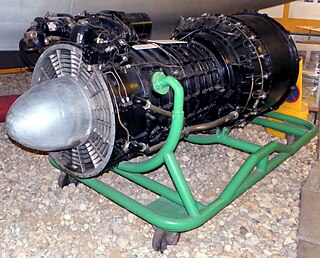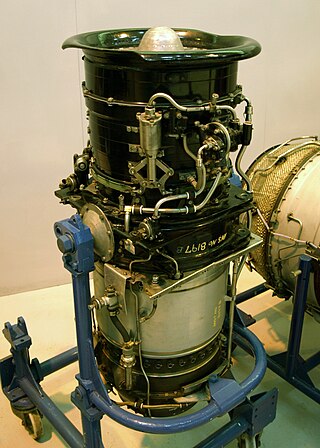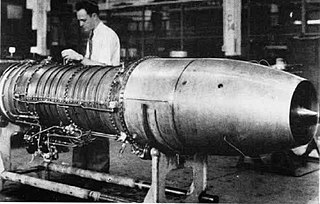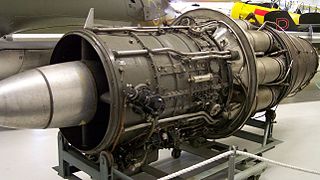
The Rolls-Royce RB.53 Dart is a turboprop engine designed and manufactured by Rolls-Royce Limited. First run in 1946, it powered the Vickers Viscount on its maiden flight in 1948. A flight on July 29 of that year, which carried 14 paying passengers between Northolt and Paris–Le Bourget Airport in a Dart-powered Viscount, was the first regularly scheduled airline flight by a turbine-powered aircraft. The Viscount was the first turboprop-powered aircraft to enter airline service - British European Airways (BEA) in 1953.

The General Electric/Allison J35 was the United States Air Force's first axial-flow compressor jet engine. Originally developed by General Electric in parallel with the Whittle-based centrifugal-flow J33, the J35 was a fairly simple turbojet, consisting of an eleven-stage axial-flow compressor and a single-stage turbine. With the afterburner, which most models carried, it produced a thrust of 7,400 lbf (33 kN).

The Armstrong Siddeley Mamba was a British turboprop engine produced by Armstrong Siddeley in the late 1940s and 1950s, producing around 1,500 effective horsepower (1,100 kW).

The Metropolitan-Vickers F.2 is an early turbojet engine and the first British design to be based on an axial-flow compressor. It was an extremely advanced design for the era, using a nine-stage axial compressor, annular combustor, and a two-stage turbine.

The Armstrong Siddeley Sapphire is a British turbojet engine that was produced by Armstrong Siddeley in the 1950s. It was the ultimate development of work that had started as the Metrovick F.2 in 1940, evolving into an advanced axial flow design with an annular combustion chamber that developed over 11,000 lbf (49 kN). It powered early versions of the Hawker Hunter and Handley Page Victor, and every Gloster Javelin. Production was also started under licence in the United States by Wright Aeronautical as the J65, powering a number of US designs. The Sapphire's primary competitor was the Rolls-Royce Avon.

The General Electric J85 is a small single-shaft turbojet engine. Military versions produce up to 2,950 lbf (13.1 kN) of thrust dry; afterburning variants can reach up to 5,000 lbf (22 kN). The engine, depending upon additional equipment and specific model, weighs from 300 to 500 pounds. It is one of GE's most successful and longest in service military jet engines, with the civilian versions having logged over 16.5 million hours of operation. The United States Air Force plans to continue using the J85 in aircraft through 2040. Civilian models, known as the CJ610, are similar but supplied without an afterburner and are identical to non-afterburning J85 variants, while the CF700 adds a rear-mounted fan for improved fuel economy.

The Wright J65 was an axial-flow turbojet engine produced by Curtiss-Wright under license from Armstrong Siddeley. A development of the Sapphire, the J65 powered a number of US designs.

The Armstrong Siddeley Viper is a British turbojet engine developed and produced by Armstrong Siddeley and then by its successor companies Bristol Siddeley and Rolls-Royce Limited. It entered service in 1953 and remained in use with the Royal Air Force, powering its Dominie T1 navigation training aircraft until January 2011.

The Armstrong Siddeley ASX was an early axial flow jet engine built by Armstrong Siddeley that first ran in April 1943. Only a single prototype was constructed, and it was never put into production. A turboprop version as the ASP was somewhat more successful, and as the Armstrong Siddeley Python saw use in the Westland Wyvern.

The de Havilland PS.23 or PS.52 Gyron, originally the Halford H-4, was Frank Halford's last turbojet design while working for de Havilland. Intended to outpower any design then under construction, the Gyron was the most powerful engine of its era, producing 20,000 lbf (89 kN) "dry", and 27,000 lbf (120 kN) with reheat.

The Bristol Siddeley Orpheus is a single-spool turbojet developed by Bristol Siddeley for various light fighter/trainer applications such as the Folland Gnat and the Fiat G.91. Later, the Orpheus formed the core of the first Bristol Pegasus vectored thrust turbofan used in the Harrier family.

The Armstrong Siddeley Python was an early British turboprop engine designed and built by the Armstrong Siddeley company in the mid-1940s. Its main use was in the Westland Wyvern, a carrier-based heavy fighter. The prototypes had used the Rolls-Royce Eagle piston engine, but Pythons were used in production aircraft. In this application, the Python was rated at 4,110 equivalent shaft horsepower (eshp).

The Turbomeca Marboré is a small turbojet engine that was produced by Turbomeca from the 1950s into the 1970s. The most popular uses of this engine were in the Fouga CM.170 Magister and the Morane-Saulnier MS.760 Paris. It was also licensed for production in the United States as the Teledyne CAE J69.

The Rolls-Royce RB.108 was a British jet engine designed in the mid-1950s by Rolls-Royce specifically for use as a VTOL lift engine. It was also used to provide horizontal thrust in the Short SC.1.
The Armstrong Siddeley Snarler was a small rocket engine used for mixed-power experiments with an early turbojet engine. and was the first British liquid-fuelled rocket engine to fly.

The Westinghouse J30, initially known as the Westinghouse 19XB, was a turbojet engine developed by Westinghouse Electric Corporation. It was the first American-designed turbojet to run, and only the second axial-flow turbojet to run outside Germany.

The General Electric J73 turbojet was developed by General Electric from the earlier J47 engine. Its original USAF designation was J47-21, but with innovative features including variable inlet guide vanes, double-shell combustor case, and 50% greater airflow was redesignated J73. Its only operational use was in the North American F-86H.

The Napier Naiad is a British turboprop gas-turbine engine designed and built by D. Napier & Son in the late 1940s. It was the company's first gas turbine engine. A twin version known as the Coupled Naiad was developed but both engine projects were cancelled before finding a market. The Naiad was also used, in adapted form, in the Napier Nomad turbo-compound engine design.

The Turbomeca Gabizo was a small turbojet engine produced by Turbomeca from the 1950s. The components were designed to take the stresses of high-speed fighter aircraft with some variants featuring afterburner.

The STAL Dovern was a Swedish turbojet design of the early 1950s, named after a lake in Finspång municipality in Östergötland, Sweden. Intended to power the Saab 35 Draken, this aircraft was powered by the Rolls-Royce Avon instead. The Dovern did not enter production.



















